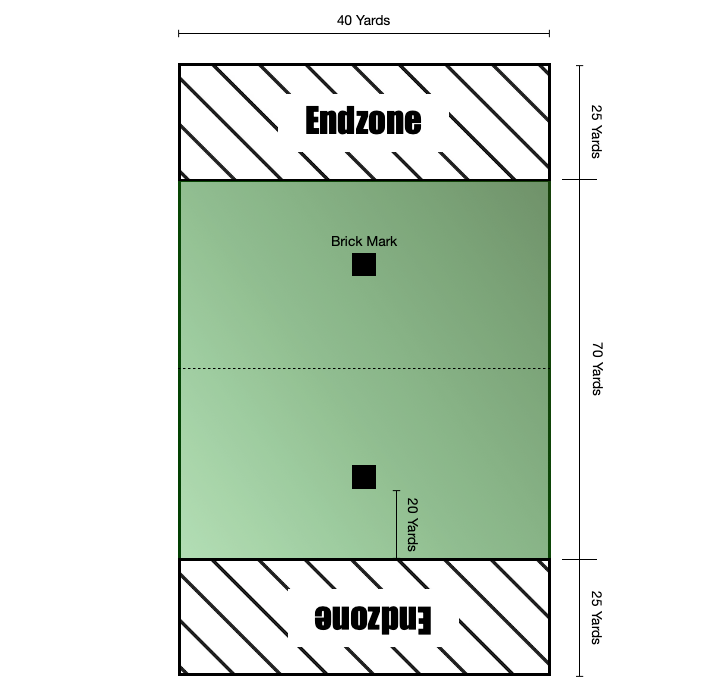Outdoor Ultimate Frisbee Rules
The rules for Ultimate Frisbee are relatively easy. The entire game can be broken down into 10 parts that are explained thoroughly below. These are simple rules for Ultimate Frisbee meant for beginners.
*Indicates terms found on our Vocab and Definitions page

1) The Ultimate Field
An Ultimate Frisbee field is 40 yards (37 meters) wide and 120 yards (110 meters) long, however almost any size will work as long as both sides of the field are equal. Each end zone is 25 yards deep and the playing area is 70 yards. A human step is on average about one yard long so the easiest way to measure out a field on the fly is to count your steps.
A Brick Mark* is centrally located on both sides of the field 20 yards (18 meters) from the end zone. "Bricks" sometimes aren’t marked, even at official tournaments, so it is important to remember that Bricks are 20 steps in-field.
The entire 40 x 120 box is the playing field. If the frisbee leaves this area it will be considered out-of-bounds. The exact center of the field is 20 yards from the sideline and 35 yards from the end zone line.
Now, you have everything you need to set up an the perfect Ultimate field.
2) The Team
There are only 7 players per team allowed on the field at one time. An Ultimate team can consist of as many players as the team wants. An average team has about 12-18 players.
Unlike other sports, men and women can play together on one team. Most captains agree to do a 5-2 ratio which means 5 guys on the field and 2 girls. This may vary depending on what captains agree on. If one team is short a girl then the captains may agree to do “offense dictates.” This means that the defending team does not need to have a girl on the field but the team on offense does. This gives the girl a break if she is the only female.
Subbing can only be done in between points. An exception is if a player gets hurt mid-point they can switch out with a sub. In Indoor Ultimate subbing is “on the fly” meaning players can come in and out as they please, similar to ice hockey.
3) Starting the Game
Before the game, captains will meet up and talk about rule changes and Flip for Disc*. 7 members from each team will go to their end zone lines. Both teams cannot cross the end zone line until the disc has been thrown. The team with the disc will raise the disc high above their head when they are ready. If the other team is ready they will raise a hand symbolizing they are ready for play. The defending team will then Pull* the disc to the other side.
If the disc lands out of bounds then the other team has an option to “Brick.” This means they can take it from where the disc went out on the sideline or bring the disc to the Brick Mark*.
If the disc lands in bounds and rolls out then it must be taken from where it went out, cannot Brick.
If a receiving player drops the Pull* then there will be a turnover. If the catch is made then play will resume.
Every point thereafter will start the same way.

4) Movement
A team has possession of the disc until it is defended, caught by the other team, thrown out of bounds, turned by a foul, or hits the ground. A player cannot run with the disc. They can only take a few steps to slow down if running while catching the disc. A player cannot “slow down” into the end zone. The person with the disc has only 10 seconds to throw the disc, assuming someone is Stalling* them. If a turnover occurs the team that was on offense is now on defense, and visa versa.
5) Scoring
A point can only be made by making a catch in the opposing end zone. Two feet must land in bounds for the point to count.
If a player jumps up to make a catch then lands with one foot in and one foot out they are “straddling” the line and the point will not count. If this happens between the end zone and out-of-bounds then the disc will be considered out and it will result in a turnover. When/if a straddle happens between the end zone and playing field the the player still has possession, but will just have to take a step out of the end zone and resume play.
After every point the team that was scored on will have to walk to the other end zone and wait for the next Pull*. Both teams switch sides every point. The time between points is 90 seconds long. This is a good time to rest, take a sub, or discuss plays before the next point starts.
7) Everybody is in control
Besides at the national level, Ultimate Frisbee lacks real refs. Instead every player is a ref. Players are responsible for calling their own fouls and calls. Only the player that is fouled can call a foul. The player that allegedly fouled is able to contest the call or not contest. Not contesting means that the player knows he/she fouled and that they will give the advantage to the opposing player. A contested foul means that the accused did not agree with the foul which usually results in a re-do. In Ultimate, the key element is respect for one another so players don’t mind owning up to a mistake. This is called the Spirit of the Game (See Number 10).
If a player makes a catch right on the sideline which may have appeared in or out it is up to the players with the “best perspective” to decide. This can be people on the sideline or in bounds. Whoever has the clearest view has the most say in the matter.
8) Fouls
There are many different fouls that can occur. The outcome of a foul changes upon whether or not the foul is contested or not. “Contest” basically means that the accused agrees with the foul or not. If they agree that they fouled, the foul call gives the fouled player an advantage by giving them essentially a “re-do” by restarting the stall count and giving possession of the frisbee.
Fouls can get tricky at times, but remember, Ultimate is a sport where everyone is a ref. If a true fouls really happened that multiple people agree on the call should benefit the fouled player, if a call was made and the majority disagrees then the call will be “neutral” and benefit either player.
9) Finishing The Game
A game is completed when the game total/point cap is reached or when the time runs out. Whichever comes first. Some games can be just timed or just have a point cap, it depends on league rules or captains agreement. When it comes to time limits there is a soft cap and a hard cap. To make this easy lets talk about a game that has both a time limit and a point cap.
Soft Cap* = 60 minutes Hard Cap* = 70 minutes Game total = 15 points Point Cap = 17 points
To win by point cap: In ultimate you must reach the game total and be two points ahead of your opponent to win. So if you score 15 points and the other team has 13 points or less, you win. If you score 15 points and the other team has 14 points, the new game total will be 16 (assuming the other team stays at 14). There is a chance both teams will be evenly matched and neither team will be able to get two points ahead. This is where the point cap comes in. No matter what, the first team to score 17 points wins.
To win by time cap: So say it has been a really long game, your winning 12-11 and exactly 60 minutes have gone by. Soft cap kicks into gear. This means that although the game is supposed to go to 15 points, it is now win-by-two. Meaning that a score of 13-11 or 14-12 can win the game. But the teams are very even, 10 more minutes go by and the score is still 12-11. When hard cap is called at the 70 minute mark the team with the most points wins, There is no win-by-two rule anymore. In this case your team would win 12-11. If by chance both teams are tied when hard cap is reached the team to score the next point wins.
Note: These caps and limits are just examples. Real caps and limits vary based on the league or tournament.
==
10) Spirit Of The Game
The golden rule: Treat others how you expect to be treated. Since Ultimate Frisbee lacks refs it is up to each player to make fair and un-bias calls. The spirit of the game is the overall sportsmanship and respect that players have for one other and the rules of Ultimate. It is a reminder to the players not to abuse the power of self-officiating, especially in the competitiveness of an intense game. You can find out everything you need to know about Spirit of the game Here.
